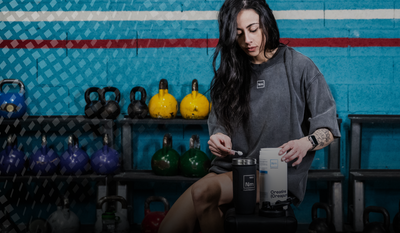0 commentaires
You've probably heard someone say that you need to "calculate your macros" if you want to achieve your goals. How important is it to calculate your macronutrients when practicing sports? Nutrimuscle explains why it is important to quantify your nutritional intake and how to do it.
Table of Contents
Macronutrients
Macronutrients are molecules represented by proteins, carbohydrates and lipids. They are not to be confused with micronutrients which are found in the form of vitamins, fibers and minerals.
It is essential to know the different macronutrient groups and their functions in order to adapt the quantities according to your objective.
Proteins
Proteins are the building blocks of our muscle tissues. They are responsible for their development and repair. An athlete is encouraged to eat more protein to accelerate the development of muscle mass and the recovery process. Proteins are also responsible for biological processes, such as detoxification of the body, the production of enzymes, hormones and the strengthening of immune defenses.
Protein is found in meat, eggs, fish, quinoa, soy, legumes and dairy products.
One gram of protein provides 4 kcal.
Carbohydrates
Carbohydrates, or carbohydrates, are the main source of energy used by the body. Carbohydrates are broken down into glucose to be used during exercise, or into glycogen which is stored in the muscles and liver, in case of later need.
Carbohydrates include sugars, fibers, and starches. Carbohydrates are found in bread, pasta, fruits, cereals, and legumes. To maintain digestive health, it is best to choose whole carbohydrate sources with a low glycemic index. In this way, it is possible to control the secretion of insulin, the hormone responsible for fat storage and weight gain.
Lipids
Lipids are the fats responsible for hormone production, immune defenses, nutrient absorption and proper brain function.
Lipids are found in oily fish, avocado, oils, and nuts. It is best to turn to sources of lipids rich in omega-3, such as dried fruits or oily fish, in order to benefit from their benefits.
Also a source of energy, lipids are twice as caloric as carbohydrates or proteins. One gram of lipid is equivalent to 9 calories.
Why calculate your macros?
Defining your sporting goals involves an adapted program, both in terms of sport and nutrition. Indeed, the body needs an energy intake to be able to function.
Depending on the objectives (weight loss, mass gain), the energy needs and the distribution of macronutrients will be different.
In the context of weight loss, a nutritional plan with a calorie deficit can be defined. Conversely, for mass gain, it will be advisable to consume more than your daily caloric needs. When cutting, proteins will be favored in the majority in the distribution of macronutrients.
Calculators
There are many online calculators that allow you to calculate your macronutrients. However, they are very approximate. All bodies are different and needs depend on many parameters. The calculators take an average of energy needs (2000 kcal for men, 1600 kcal for women), so the result of the calculation gives an average. The result can be specified by adding height, weight, age and level of physical activity.
However, there are databases to calculate the caloric intake of your meals. Among the easy-to-use applications, there is MyFitnessPal or FatSecret. They allow you to quickly calculate the calories consumed according to a large selection of foods.
Define your needs: calculate your basic metabolism (BMR)
Basal metabolism (BMR) depends on several factors as mentioned above: age, sex, height, weight. It represents the calorie requirements that the body needs daily to ensure vital functions at rest.
There are several formulas for knowing your daily caloric needs:
For men: 10 x weight (in kg) + 6.25 x height (in cm) – 5 x age (in years) + 5
For women: 10 x weight (in kg) + 6.25 x height (in cm) – 5 x age (in years) - 161
For men: 13.707 x weight (kg) + 492.3 x height (m) – 6.673 x age (in years) + 77.607
For women: 9.740 x weight (kg) + 172.9 x height (m) - 4.7373 x age (in years) + 667.051
Calculate your daily energy requirements (DEJ)
Daily energy needs include metabolism and activity level. In other words, this is the value that indicates precisely how many calories you need, depending on your lifestyle. Simply multiply the value of the basal metabolic rate (BMR) according to your level of physical activity:
- Sedentary: x 1, 2
- Light physical activity: x 1.375
- Moderate to vigorous physical activity: x 1.64
- Intensive physical activity: x 1.9
Calculate your macronutrients
Thanks to the calculation of basal metabolism (BM) and daily energy requirements (DEJ), it is now possible to calculate macronutrients according to the determined objective.
The amount of protein
Protein should make up at least 15% of your daily diet. This rate varies depending on whether you are gaining or losing weight.
A sedentary person needs 0.8 to 1g of protein per kg of body weight.
For a strength athlete, it is recommended to consume 1.6g of protein per kg of body weight.
For an endurance athlete, it is recommended to consume 2g of protein per kg of body weight.
The amount of lipids
It is recommended to consume 1 gram of lipids per kg of body weight. Sources of unsaturated fats should be favored (nuts, oily fish, etc.).
The amount of carbohydrates
Carbohydrates complete the rest of the diet. Its rate will be higher in the context of mass gain or lower in the context of weight loss. It is recommended to turn to sources of carbohydrates with a low glycemic index, as mentioned above (legumes, whole grains). The secretion of insulin will be less important and will guarantee a better satiety effect.






























